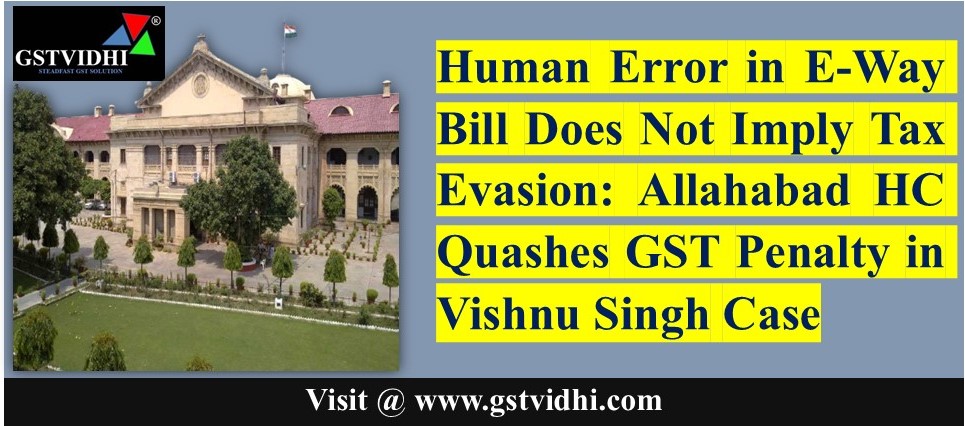
Human Error in E-Way Bill Does Not Imply Tax Evasion: Allahabad
HC Quashes GST Penalty in Vishnu Singh Case
Introduction
The GST regime in India
is structured to enable seamless flow of goods through transparency and
technology-driven compliance tools like e-way bills. However, the system must
also recognize human fallibility. In the landmark case of M/s Vishnu Singh
vs State of U.P. and Others, the Allahabad High Court reiterated that technical
errors or clerical mistakes in e-way bills—absent intent to evade tax—cannot
justify punitive action under Section 129(3) of the GST Act.
Case
Snapshot
- Case Title:
M/s Vishnu Singh vs State of U.P. and Others
- Writ Tax No.:
599 of 2024
- Neutral Citation No.:
2025:AHC:24812
- Court:
High Court of Judicature at Allahabad, Court No. 2
- Judgment Reserved:
—
- Judgment Delivered:
20 February 2025
Facts of
the Case
The petitioner, M/s
Vishnu Singh, a proprietorship firm engaged in civil construction works,
purchased 24.948 kg of durapave bitumen from M/s Indian Oil
Corporation, Mathura, on 29 August 2023.
Key events unfolded as
follows:
- The e-way bill generated on
29.08.2023 mistakenly reflected SAP Document No. 770455482 instead
of the actual tax invoice number due to a technical/human error.
- On 30.08.2023, while goods
were being transported from Mathura to Mirzapur, the vehicle was intercepted
at Anant Ram Toll Plaza, Etawah.
- Authorities found no discrepancy
in the goods, tax invoice, bilty, or transporter documents—only the
mismatch in the invoice number between the e-way bill and physical
invoice was cited.
- A penalty was imposed under
Section 129(3) of the GST Act by order dated 04.09.2023.
- The appeal filed by the petitioner
was rejected on 20.03.2024, prompting the present writ petition.
Petitioner’s
Arguments
Represented by Shri Rishi
Raj Kapoor, the petitioner raised the following contentions:
1. Clerical Error, Not
Malicious Intent
- The wrong mention of SAP Document
No. in place of the tax invoice number on the e-way bill was due to human
error.
- The SAP document number was also
included on the tax invoice, so there was no discrepancy in
identifying the goods.
2. No Other Deficiency
- All documents such as tax invoice,
bilty, and consignment note were valid and present.
- The authorities did not point out
any inconsistency in quantity, value, or description of goods.
3. Absence of Mens Rea
- No finding
was recorded by the tax authorities indicating that the petitioner
intended to evade tax.
- Without proving intent to evade,
penalty under Section 129(3) is not sustainable.
4. Purpose of E-Way Bill
- The e-way bill's primary role
is to inform the department about goods in transit to prevent tax evasion.
- This objective was met in the present
case.
5. Reliance on Precedents
- Relied on:
- M/s Zhuzoor Infratech Pvt. Ltd. vs
Addl. Commissioner (Writ Tax No. 830/2024, decided on 14.02.2025)
- M/s Sun Flag Iron & Steel Co.
Ltd. vs State of U.P. (2023:AHC:215906)
Respondent’s
Contentions
The State opposed the
petition, arguing that:
- The petitioner had violated Rule
138 by failing to correctly generate the e-way bill.
- The mismatch between invoice and
e-way bill warranted initiation of penalty proceedings.
- The e-way bill was never corrected
or updated, even after interception.
Key
Observations by the Court
Justice Piyush Agrawal
carefully examined the facts and made the following crucial observations:
1. Admitted Clerical
Discrepancy
- The mismatch related only to the invoice
number—SAP document number was entered instead, which was not
a fake number, but actually present in the tax invoice.
- Thus, it was not a deceptive entry,
but a labeling error.
2. No Other Infirmity
- The goods matched the tax invoice.
- No discrepancy was found in description,
quality, or quantity.
3. Absence of Intent to
Evade
- The entire record lacked any
mention or evidence of intention to defraud or evade tax.
- The sole basis for penalty was
a technical misstatement—not a justifiable ground under Section
129.
Court’s
Reliance on Precedents
1. Zhuzoor Infratech
Pvt. Ltd. (Writ Tax No. 830/2024)
“The purpose of e-way
bill is to inform the department about movement of goods… If it’s not canceled
within its validity, the genuineness of transaction cannot be questioned.”
2. Sun Flag Iron &
Steel Company Ltd. (2023:AHC:215906)
“Once the e-way bill has
not been canceled and was in existence during interception, the movement of
goods and genuineness of transaction stand verified.”
Key
Takeaways from the Judgment
- Clerical mistakes
in an e-way bill do not imply fraud.
- No penalty can be levied
under Section 129(3) unless there is clear evidence of intent to evade
tax.
- The objective of the e-way bill
is achieved once the goods’ movement is transparent and trackable, even if
one field is erroneous.
Final
Verdict
The High Court delivered
the following ruling:
- The impugned penalty order dated
04.09.2023 and appellate order dated 20.03.2024 were quashed.
- The writ petition was allowed.
- The petitioner is entitled to a
refund of any amount deposited pursuant to the impugned orders.
Conclusion:
GST Enforcement Should Respect the Spirit of Law
This judgment reaffirms
that GST compliance mechanisms like the e-way bill are tools for
transparency, not traps for technical slips. In absence of any
fraudulent intention or tax evasion, penalty provisions must be applied
judiciously.
The Court rightly
protected the petitioner’s interest by quashing proceedings based solely on a harmless
human error.
Disclaimer: All the Information is based on the notification, circular and order issued by the Govt. authority and judgement delivered by the court or the authority information is strictly for educational purposes and on the basis of our best understanding of laws & not binding on anyone.
Find the Attachment (Press on Click Here )
Click here